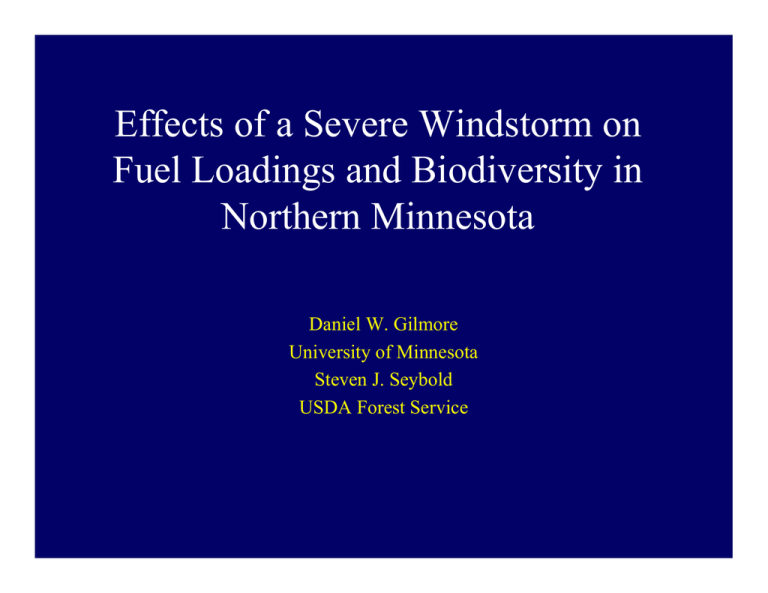Effects of a Severe Windstorm on Fuel Loadings and Biodiversity in
advertisement

Effects of a Severe Windstorm on Fuel Loadings and Biodiversity in Northern Minnesota Daniel W. Gilmore University of Minnesota Steven J. Seybold USDA Forest Service Outline • What happened? • Research • Results & Applicability What happened? It was a really big storm! Derecho downburst development From COMET, 1999, modified from Weisman, 1993. May 30-31, 1998 Bow echo derecho (6 dead, 190 injured, $291,000,000 damage). From: R.H. Johns and J.S. Evans: www.spc.noaa.gov/misc/AbtDerechos Damage from the July 4, 1999 Super-cell derecho in the BWCAW Minneapolis Star tribune Lo’ Down on the Gunflint Blow-Down • Gunflint was 3% of total area affected (14,339 ac out of 477,000 ac) • Federal – 10,558 ac • State – 1,325 ac • County – 293 ac • Private – 1,609 ac Overview of Experimental Design • A two factor ANOVA design • Covertype • Fuel reduction treatment Aspen-Birch-Conifer Undisturbed Jack Pine Undisturbed Aspen-Birch-Conifer Unsalvaged Jack Pine Unsalvaged Aspen-Birch-Conifer Salvage Jack Pine Salvage Aspen-Birch-Conifer Mechanical Pile Aspen-Birch-Conifer Prescribed Burn Research • Framework, field crews, summer housing -Chippewa National Forest • Fuel reduction research – Joint Fire Sciences Program • Research on shrub community dynamics -Chippewa National Forest • Research on the insects -Forest Health Monitoring Program Study Sites in the Superior National Forest *sites not shown to same scale Site Layout Y # Y # Y # Y # Y # Y # Y # Y # Y # Y # Y # Y # Y # Y # 36.0 Y # Y # Plot Layout Design Fuel Reduction Treatment Results Summary • Salvage harvesting was most successful in reducing total fuel loadings • Prescribed burns were very effective in reducing fine fuel loadings • 15 – 20 fuel sampling transects are necessary per location (forest stand) to obtain adequate fuel loading estimates Shrub Community Results Summary • No detectable differences in average total aboveground biomass • Greatest changes in shrub species dominance occurred followed salvage logging in both cover types • A shift from a jack pine cover type to an aspen cover type is likely following salvage logging • The aspen-birch-conifer cover type appears stable following all fuel reduction treatments CHANGES IN FOREST COVER-TYPES Pine Stands Aspen Stands Pre-settlement Vegetation 1800s Tester (1995) Post-settlement Vegetation 1900s Scaphinotus species Pterostichus melanarius Summary of Ground Beetle Results • Aspen/birch/conifer had greater trap catches while jack pine forests had greater species diversity. • Some species were caught exclusively in each cover type. • A number of species were caught in greater numbers in the undisturbed than wind-disturbed forests. • Species diversity was greater in the wind-disturbed than undisturbed forests. • Pterostichus melanarius was caught in greatest numbers in the jack pine burned forests. • Salvaged and burned forests had the greatest trap catches, species richness and diversity, and most unique assemblages. SEMIOCHEMICAL TREATMENTS FOR FUNNEL TRAPS (A) Scolytidae Beetle Species Baits Ips grandicollis (–)-ipsenol, (–)-α-pinene Ips perroti (–)-ipsenol, (–)-ipsdienol Ips perroti (–)-ipsenol, (+)-ipsdienol Ips perturbatus (–)-ipsenol, (+)-ipsdienol, (–)-cis-verbenol Ips pini (+/–)-ipsdienol, lanierone D. rufipennis (+/–)-frontalin, (–)-α-pinene, methylcyclohexanol D. simplex (+/–)-seudenol, (–)-α-pinene D. valens (+)-α-pinene, (–)-β-pinene D. valens (+)-α-pinene, (–)-β-pinene, 3-carene Dryocoetes spp. (+/–)-exo-brevicomin, (–)-α-pinene Dryocoetes spp. (+/–)-endo-brevicomin (B) Wood-boring Beetles Beetle Species Baits Buprestidae Ethanol, (–)-α-pinene Cerambycidae Ethanol, (–)-α-pinene (C) Blank Trap (control) Werner et al. (1981) Teale et al. (1991) Hobson et al. (1993) Borden et al. (1996) Camacho et al. (1998) Holsten et al. (2000) Summary of Subcortical Insects Results • • Trap catches of some of the abundant subcortical insects were greater in wind-disturbed and burned areas two years after the storm (2001). Trap catches declined thereafter (in 2003). • Wind-disturbance event and burning increased species richness and diversity on the landscape. • Species composition of the salvaged and burned forests were distinct. • Semiochemicals were effective tools to monitor subcortical insect biodiversity. • Responses of insects to semiochemicals varied strongly with the year of sampling and land-area treatments. Summary of Subcortical Insects Results • Dendroctonus simplex bait caught the greatest number of insects. • Most subcortical species were caught using their respective baits. • Dendroctonus valens & Dryocoetes spp. baited traps, and unbaited traps had the greatest species diversity. So, what does all this tell us? • That depends …….. • Recall salvage logging appears to foster a shift in forest cover type – from conifer to aspen • But, prescribed fire seems to promote the presence of an exotic ground beetle ….. TRAP CATCHES OF ALL GROUND BEETLES N=4 (2001-2003) Total No. of Beetles = 19,859 Mean (+SE) No. of Ground Beetles Caught in Unbaited Pitfall Traps in 1000 Trap-days 1000 b 800 Aspen/Birch/Conifer Forests Jack Pine Forests 600 a a 400 c 200 0 Undisturbed Wind-disturbed Salvaged Burned Three-factor ANOVA: None of the interactions were significant; Forest cover-types (P < 0.001); Year (P > 0.05); Land-area treatments (P < 0.001). REGW pairwise comparison tests, α = 0.05. And, • In addition to creating a high fire danger situation, • Doing nothing creates a situation where high populations of insects that are normally not a significant threat become a major problem Options for Creating & Maintaining a Healthy Forest • Determine DFC (Desired Future Condition) • Use thinning and timber harvestings as a tools to shift species composition, • And promote a forest less prone to windthrow • Monitor the residual forest


